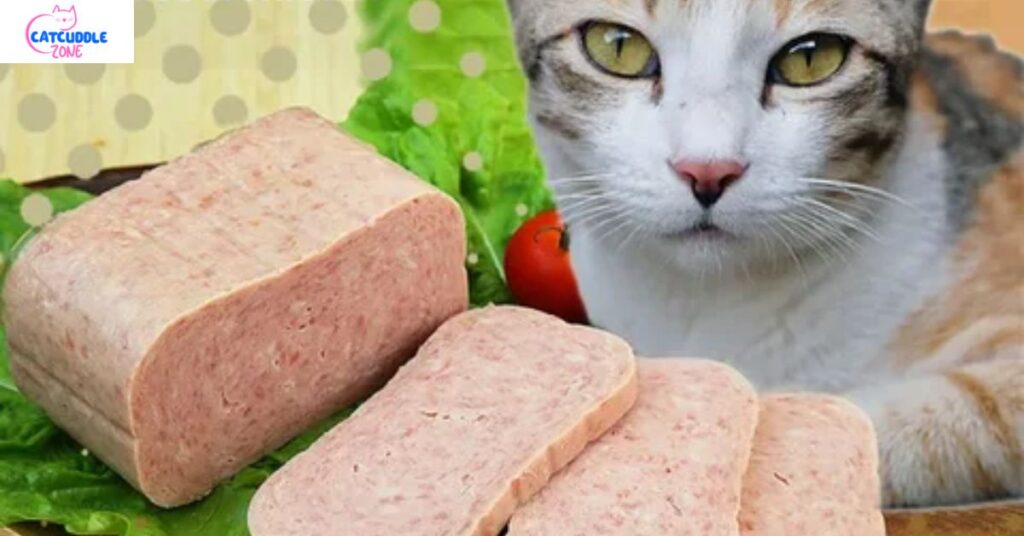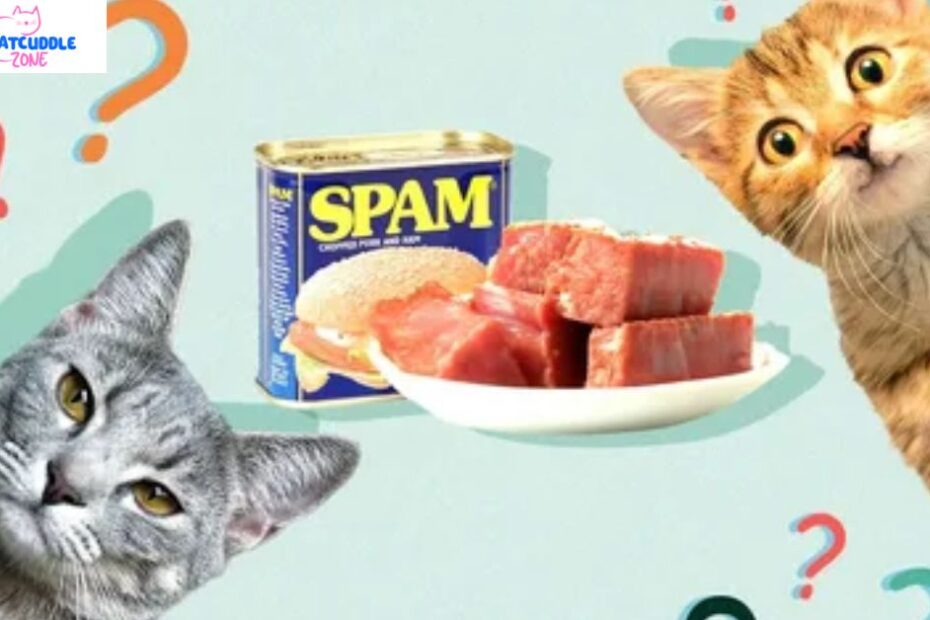That unmistakable aroma of sizzling processed canned meat might tempt you to share a bite of Spam with your curious cat. However, this popular human pantry staple hides significant risks for felines. While not immediately poisonous in tiny amounts, Spam’s dangerously high sodium content and harmful preservatives like sodium nitrite can lead to severe salt toxicosis and other health issues.
Understanding these dangers is crucial for any responsible pet owner. This guide will provide essential veterinary advice on the immediate and long-term health consequences of feeding Spam to cats, arming you with the knowledge to keep your beloved pet safe and healthy.
What Exactly Is Spam?
Many people in the USA love Spam, especially in places like Hawaii. The Hormel Foods Corporation makes this product. It is a canned mix of pork and ham that is cooked and preserved. While it is a popular food for people, it is not made for animals at all. Its long shelf life comes from how it is made, which is the main problem for pets.
Spam is what we call a highly processed food. This means it has been changed a lot from its original state. It contains many additives to keep it fresh and make it taste good to humans. These ingredients do not fit a cat’s natural diet at all. Cats are obligate carnivores. This means they need to eat meat, but they need the right kind of meat without extra stuff.
The Short Answer: Can Cats Eat Spam?
The simple answer is no, cats should not eat Spam. It is not a good food for them. While a tiny bite might not cause a crisis, it is very unhealthy. Is Spam poisonous to cats in small amounts? Not exactly, but it offers them no good nutrition. It is like giving them junk food that can make them sick.
Can a little bit of spam hurt a cat? It might. Why is spam bad for cats? Because it is full of things their bodies cannot handle well. Regularly feeding it to your cat can lead to long-term health consequences. It is much safer to just avoid giving them any at all. Their health is worth more than a moment of sharing.
Breaking Down the Ingredients: Why Spam is Harmful
The reason Spam is dangerous for cats is all in the ingredients list. Each component poses a unique problem for a cat’s small body. The main ingredients include pork with ham, salt, sugar, potato starch, and sodium nitrite. These are all used for flavor or as preservatives in pet food, but they are bad for cats.
The high sodium content is a huge concern. It can easily lead to salt toxicosis. Sodium poisoning symptoms include vomiting, diarrhea, and even seizures. Another item, sodium nitrite, causes oxidative stress which damages cells. Even potato starch is useless for cats. They need meat protein, not carbs. This combination creates a serious nutritional imbalance.
Common Toxic Ingredients in Spam Varieties
| Spam Variety | Potentially Harmful Ingredient | Risk to Cats |
| Classic | High Sodium, Sodium Nitrite | Salt Toxicity, Oxidative Stress |
| Hot & Spicy | Spices, Seasonings | Gastrointestinal upset |
| Jalapeño | Onion/Garlic Powder (potential) | Onion and garlic toxicity |
| Maple | Sugar, Flavorings | Obesity, Diabetes |
Immediate Health Risks of Feeding Spam to Your Cat
Giving your cat Spam can make them sick very quickly. One of the first signs of trouble is gastrointestinal upset. Your cat might vomit or have diarrhea soon after eating it. This is their body trying to reject the unhealthy food. My cat ate spam and threw up is a common worry for owners who discover a stolen bite.
The fat in Spam can also cause a very serious condition called pancreatitis. This is a painful inflammation of the pancreas. It makes a cat very lethargic and sick and needs emergency vet care right away. High salt can also cause extreme thirst and tremors. Knowing the symptoms of a cat eating spam can help you act fast if there’s a problem.
My Cat Ate Spam! What Should I Do?
I accidentally fed my cat spam or my cat ate spam what do I do? First, don’t panic. Stay calm. Figure out how much they ate and what kind it was. If it was a flavor with garlic or onion, the risk is higher. Check your cat for any signs of sickness like vomiting or acting tired.
Your next step is very important. You should call your veterinarian immediately. Explain what happened and what kind of Spam it was. They will give you the best advice. You can also call the ASPCA Animal Poison Control Center at (888) 426-4435. They offer online vet chat for pet emergency help too. It is always better to be safe and get expert help.

Vet-Approved Healthy Alternatives to Spam
You have many great choices instead of Spam. Cats will love these healthy cat treats that are also safe for them. The best options are plain cooked meats like baked chicken breast or turkey. Make sure the meat is cooked plain with absolutely no salt, seasoning, or oils added to it.
You can also find many vet recommended cat treats at the store. Look for brands that have a short list of natural ingredients. Another easy option is to use a spoonful of high-quality commercial cat food or wet food as a special reward. These species-appropriate treats give your cat the protein they crave without any of the risks. What to feed my cat instead of spam is easy once you know these simple swaps.
Beyond Spam: Other Human Foods to Avoid
Spam is just one of many human foods toxic to cats. It is good to know the full list of things cats can’t eat to keep your pet safe. Some common foods are very dangerous. Chocolate, grapes, and raisins can cause serious illness or even death in cats. Onions and garlic are also very toxic and can damage their red blood cells.
It is also important to avoid giving cats any food with caffeine or alcohol. Even a small amount can be extremely dangerous. Instead of wondering what happens if a cat eats spam or other human food, stick to their regular cat food. Knowing the foods that are toxic to cats helps you create a safe home for your pet.
Final Thoughts: Keeping Your Cat Safe and Healthy
The best way to show your cat love is by feeding them a healthy diet. Can cats have Spam luncheon meat? We know the answer is no. Their bodies are designed for a specific obligate carnivore diet. Giving them human food like Spam can cause too many problems. It is not worth the risk to their health.
Always select good human food for cats, such as plain meats or cat-safe cat food. Your veterinarian is the most reliable person to consult when you are in doubt. They would assist you in the best cat food to feed your cat, depending on its age and health. By not letting your cat into risky foods, you will be keeping them safe and happy, living with you in a healthy environment.
(FAQs)
Is low-sodium Spam okay for cats?
No, not even low-sodium Spam is cat food. It is still loaded with damaging preservatives such as sodium nitrite and a lot of fat that has no nutritional value and can be hazardous to health.
How much Spam can a cat safely eat?
Cats have no safe amount of Spam. A small portion can cause gastrointestinal disturbance or fundamental health problems because of the unhealthy components.
Can I give a stray cat Spam?
One should not recommend Spam to stray cats. Use safer options such as plain cooked chicken or cat food that has been specially prepared so that it does not subject them to unnecessary health issues.
What canned meat is safe for cats?
Plain, cooked, canned meats such as chicken or turkey, which have no added salt, spices or preservatives, are safe to cats. Let the choice of a product always favor cats.
Can cats have canned spam?
Nobody should feed cats cans of Spam. It contains a lot of sodium, preservatives, and unhealthy fats; thus, it is unfit to be eaten by cats and harmful to their health.
